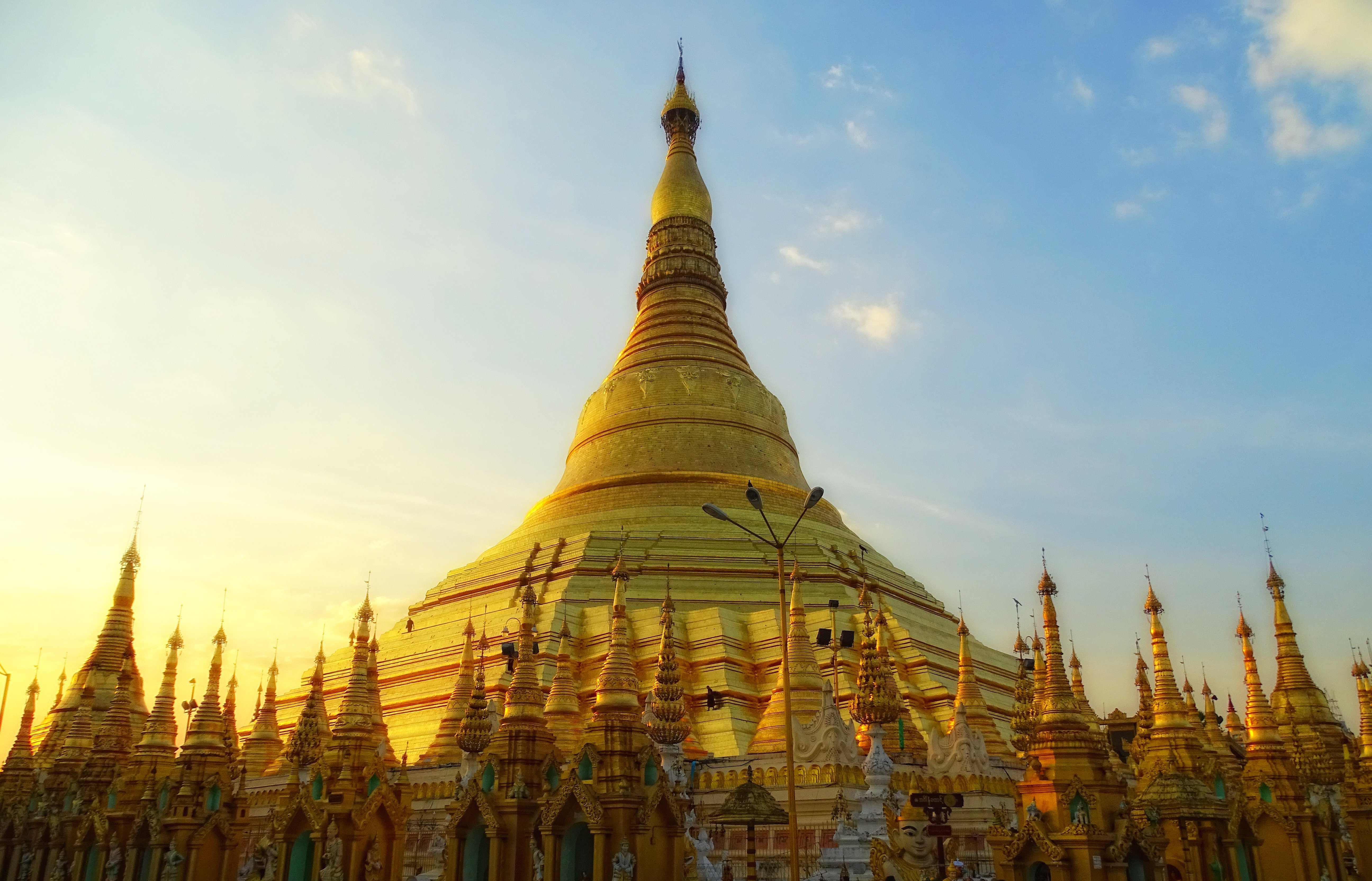|
Thamada Cinema
Thamada Cinema (), formerly known as the President Cinema, is a historic mid-century modernist movie theater in Dagon Township, Yangon, Myanmar. Completed around 1964, the Thamada complex, which includes both the cinema and hotel, is one of the city’s most iconic examples of post-war modernist architecture. The cinema has a large, oval-shaped hall and historically showcased both local and international films. It has served as a major cultural and entertainment venue in the city for decades. History Construction of the Thamada Hotel and Cinema began in the late 1950s as part of Myanmar's post-independence modernization efforts. The complex was completed in the early 1960s, with both the hotel and cinema becoming prominent fixtures in downtown Yangon. The Thamada complex was built in the international style of mid-century modernist architecture. The hotel is a seven-story concrete structure with curved facades and minimal decorative features. The adjoining cinema features an ov ... [...More Info...] [...Related Items...] OR: [Wikipedia] [Google] [Baidu] |
Alanpya Pagoda
Alanpya Pagoda (; also known as Signal Pagoda) is a Burmese pagoda located on Alanpya Hill, on the southern part of Dhammarakhita Hill, in Yangon, Myanmar. The pagoda is south of Maha Wizaya Pagoda. Names Alanpya Pagoda is known by a number of various names. During British rule in Burma, the pagoda acquired its present-day name, Signal Pagoda (Alanpya Zedi in Burmese), because it was used as a signal station for vessels coming up Yangon River. It was also known as McCreagh's Pagoda, after Brigadier McCreagh, and as Sale's Pagoda, after Lieutenant Robert Sale, who was stationed there during the First Anglo-Burmese War. The pagoda has also been known as Sandawkyo Pagoda (ဆံတော်ကြိုစေတီ), Gurkha Pagoda, and Tattoo Pagoda (တပ်ဦးစေတီ), as well as by its Mon language name, Kyaik Hapaw Cih (ကျာ်ထပှ်ထစှေ်, ). History According to the Shwedagon Chronicle, the pagoda pre-dates Shwedagon Pagoda, and was built on ... [...More Info...] [...Related Items...] OR: [Wikipedia] [Google] [Baidu] |
Dagon Township
Dagon Township ( ) is located immediately north of downtown Yangon. The township comprises five wards, and shares borders with Bahan Township in the north, Ahlon Township in the west, Mingala Taungnyunt Township in the east, and Lanmadaw Township, Latha Township and Pabedan Township in the south. Dagon is home to some of the most prominent places of the city, including the great Shwedagon Pagoda, the Maha Wizaya Pagoda, the National Museum, the National Theatre and the Yangon Region Hluttaw (Parliament). This prosperous neighborhood has many hotels, embassies and diplomatic residences. The township's Dagon 1 High School and Dagon 2 High School are considered among the top public high schools in the country. On 6 February 2011, the Taw Win Centre, a major shopping and residential complex, was opened in the township. Construction on the 25-story complex began in 2004, but was stopped during the country's banking crisis, before resuming in March 2008. The country's first 3 ... [...More Info...] [...Related Items...] OR: [Wikipedia] [Google] [Baidu] |
Yangon
Yangon, formerly romanized as Rangoon, is the capital of the Yangon Region and the largest city of Myanmar. Yangon was the List of capitals of Myanmar, capital of Myanmar until 2005 and served as such until 2006, when the State Peace and Development Council, military government relocated the administrative functions to the purpose-built capital city of Naypyidaw in north central Myanmar. With over five million people, Yangon is Myanmar's most populous city and its most important commercial centre. Yangon boasts the largest number of colonial-era buildings in Southeast Asia, and has a unique Downtown Yangon, colonial-era urban core that is remarkably intact. The colonial-era commercial core is centered around the Sule Pagoda, which is reputed to be over 2,000 years old. The city is also home to the gilded Shwedagon Pagoda – Myanmar's most sacred and famous Buddhist pagoda. Yangon suffers from deeply inadequate infrastructure, especially compared to other major cities in Sou ... [...More Info...] [...Related Items...] OR: [Wikipedia] [Google] [Baidu] |
Myanmar
Myanmar, officially the Republic of the Union of Myanmar; and also referred to as Burma (the official English name until 1989), is a country in northwest Southeast Asia. It is the largest country by area in Mainland Southeast Asia and has a population of about 55 million. It is bordered by India and Bangladesh to its northwest, China to its northeast, Laos and Thailand to its east and southeast, and the Andaman Sea and the Bay of Bengal to its south and southwest. The country's capital city is Naypyidaw, and its largest city is Yangon (formerly Rangoon). Early civilisations in the area included the Tibeto-Burman-speaking Pyu city-states in Upper Myanmar and the Mon kingdoms in Lower Myanmar. In the 9th century, the Bamar people entered the upper Irrawaddy River, Irrawaddy valley, and following the establishment of the Pagan Kingdom in the 1050s, the Burmese language and Culture of Myanmar, culture and Buddhism in Myanmar, Theravada Buddhism slowly became dominant in the co ... [...More Info...] [...Related Items...] OR: [Wikipedia] [Google] [Baidu] |
Modern Architecture
Modern architecture, also called modernist architecture, or the modern movement, is an architectural movement and style that was prominent in the 20th century, between the earlier Art Deco and later postmodern movements. Modern architecture was based upon new and innovative technologies of construction (particularly the use of glass, steel, and concrete); the principle functionalism (i.e. that form should follow function); an embrace of minimalism; and a rejection of ornament. According to Le Corbusier, the roots of the movement were to be found in the works of Eugène Viollet-le-Duc, while Mies van der Rohe was heavily inspired by Karl Friedrich Schinkel. The movement emerged in the first half of the 20th century and became dominant after World War II until the 1980s, when it was gradually replaced as the principal style for institutional and corporate buildings by postmodern architecture. Origins Modern architecture emerged at the end of the 19th century from ... [...More Info...] [...Related Items...] OR: [Wikipedia] [Google] [Baidu] |
Mid-century Modern
Mid-century modern (MCM) is a movement in interior design, product design, graphic design, architecture and urban development that was present in all the world, but more popular in North America, Brazil and Europe from roughly 1945 to 1970 during the United States's post-World War II period. MCM-style decor and architecture have seen a major resurgence that began in the late 1990s and continues today. The term was used as early as the mid-1950s, and was defined as a design movement by Cara Greenberg in her 1984 book ''Mid-Century Modern: Furniture of the 1950s''. It is now recognized by scholars and museums worldwide as a significant design movement. The MCM design aesthetic is modern in style and construction, aligned with the Modernist movement of the period. It is typically characterized by clean, simple lines and honest use of materials, and generally does not include decorative embellishments. On the exterior, a MCM home is normally very wide, partial brick ... [...More Info...] [...Related Items...] OR: [Wikipedia] [Google] [Baidu] |
Architecture Of Myanmar
The architecture of Myanmar (formerly known as Burma), in Southeast Asia, includes architectural styles which reflect the influence of neighboring and Western nations and modernization. The country's most prominent buildings include Buddhist pagodas, stupas and temples, British colonial buildings, and modern renovations and structures. Myanmar's traditional architecture is primarily used for worship, pilgrimage, storage of Buddhist relics, political activism and tourism. History Pyu period Much of Myanmar's architecture is tied to ancient Indian architecture, and can be traced to the country's earliest known inhabitants. During the Pyu period, cylindrical stupas with four archways—often with a ''hti'' (umbrella) on top—were built. The Mon and Pyu people were the first two influential groups to migrate to Myanmar, and the first Indo-Chinese adherents of Theravada Buddhism. Beikthano, one of the first Pyu centers, contains urbanesque foundations which include a monaste ... [...More Info...] [...Related Items...] OR: [Wikipedia] [Google] [Baidu] |
Cinema Of Myanmar
The cinema of Burma dates back to the 1910s. The person who created the first silent film was Ohn Maung (Burma's first producer and director). Start of the Burmese cinema The Victoria Parsi Theaterical Company which screened movies in Rangoon as early as 1898. Carl Hertz also showcased his variety shows along with a 'cinematographie' in Rangoon and Mandalay while touring the world. Burma was also on the tour map of Abdulally Esoofally's (originally Abdul Ali Yusuf Ali) 'Royal Bioscope' tent. Cultural historian Jane M. Ferguson notes, 'Changing technology and expanding consumer demand inspired entrepreneurs to build more permanent homes for this new popular entertainment.' Thus, began the construction of the first brick-and-mortar cinema halls in Rangoon. The first multiple-reel feature film screen in 1911. Burma's first film was a recording of the funeral of Tun Shein - a leading politician of the 1910s, who campaigned for Burmese independence in London. Ohn Maung capture ... [...More Info...] [...Related Items...] OR: [Wikipedia] [Google] [Baidu] |
Yangon Heritage Trust
The Yangon Heritage Trust (; abbreviated YHT) is a non-governmental organisation founded by Thant Myint-U to conserve historic buildings in Yangon (formerly Rangoon), the former capital of Burma. Yangon has Asia's largest collection of colonial-era buildings. The Trust has proposed to designate small zones within the city centre (particularly in Downtown Yangon) as heritage areas and envisions a joint public-private collaboration whereby private investors restore heritage buildings for commercial use while maintaining the character of the areas. The Trust also advocates a conservation plan led by the private sector The private sector is the part of the economy which is owned by private groups, usually as a means of establishment for profit or non profit, rather than being owned by the government. Employment The private sector employs most of the workfo .... In June 2013, Philips announced a partnership with the Trust to install 200 LED-lit blue plaques to highlight ... [...More Info...] [...Related Items...] OR: [Wikipedia] [Google] [Baidu] |
History Of Yangon
Yangon, formerly romanized as Rangoon, is the capital of the Yangon Region and the largest city of Myanmar. Yangon was the capital of Myanmar until 2005 and served as such until 2006, when the military government relocated the administrative functions to the purpose-built capital city of Naypyidaw in north central Myanmar. With over five million people, Yangon is Myanmar's most populous city and its most important commercial centre. Yangon boasts the largest number of colonial-era buildings in Southeast Asia, and has a unique colonial-era urban core that is remarkably intact. The colonial-era commercial core is centered around the Sule Pagoda, which is reputed to be over 2,000 years old. The city is also home to the gilded Shwedagon Pagoda – Myanmar's most sacred and famous Buddhist pagoda. Yangon suffers from deeply inadequate infrastructure, especially compared to other major cities in Southeast Asia, such as Jakarta, Bangkok or Hanoi. Though many historic residential a ... [...More Info...] [...Related Items...] OR: [Wikipedia] [Google] [Baidu] |
Buildings And Structures Completed In 1964
A building or edifice is an enclosed structure with a roof, walls and windows, usually standing permanently in one place, such as a house or factory. Buildings come in a variety of sizes, shapes, and functions, and have been adapted throughout history for numerous factors, from building materials available, to weather conditions, land prices, ground conditions, specific uses, prestige, and aesthetic reasons. To better understand the concept, see ''Nonbuilding structure'' for contrast. Buildings serve several societal needs – occupancy, primarily as shelter from weather, security, living space, privacy, to store belongings, and to comfortably live and work. A building as a shelter represents a physical separation of the human habitat (a place of comfort and safety) from the ''outside'' (a place that may be harsh and harmful at times). buildings have been objects or canvasses of much artistic expression. In recent years, interest in sustainable planning and building practi ... [...More Info...] [...Related Items...] OR: [Wikipedia] [Google] [Baidu] |





